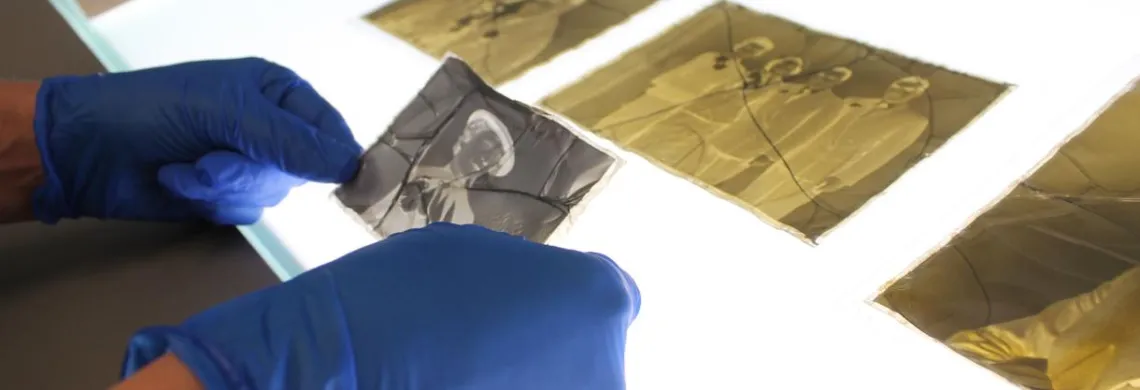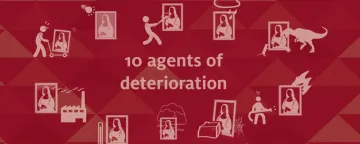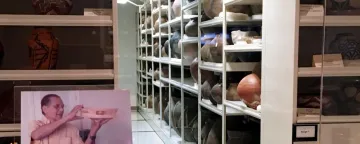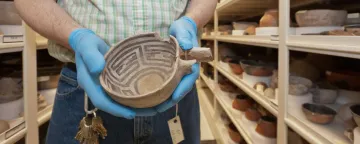Art Conservation at UArizona

The UA is home to three world-class cultural institutions: the Arizona State Museum, the Center for Creative Photography, and the UA Museum of Art. Collectively, these facilities house thousands of one-of-a-kind objects.
Among all of the objects in our collections, many are centuries old, others arrived at the University with some level of damage, but each and every single one of them is invaluable to us, and therefore we handle them with care, taking measures to prevent deterioration.
Here, we invite you to explore what causes objects to deteriorate in the first place, what art conservation is, and how we preserve invaluable collections at the University of Arizona’s three cultural institutions.
What is art conservation?
According to the American Institute for Conservation, conservation is “the profession devoted to the preservation of cultural property for the future. Conservation activities include examination, documentation, treatment, and preventative care, supported by research and education.” Conservation is a mix of art and science, and is very much a problem-solving process. Art conservation exists to not only celebrate culture and creativity, but to ensure the integrity of art objects for future generations.

What are the 10 agents of deterioration?
Pests: Cockroaches, silverfish, firebrats, certain types of beetles, mold, and mildew are things that can eat away at an object with time.
Light: Organic materials are particularly susceptible to irreparable damage induced by prolonged exposure to high levels of light. Visible light, along with infrared heat and ultraviolet radiation, must be controlled and/or eliminated from the gallery environment to prevent light-sensitive materials and objects from fading, darkening, or from becoming brittle over time. This is why museum exhibitions usually are so dimly lit and prohibit flash photography.
Theft and Vandalism: Theft and vandalism occur under a wide variety of circumstances. About 80 percent of U.S. museum thefts reported to the National Stolen Art File are committed internally, by staff or those in a position of trust. These works are stolen most often from collection storage areas rather than exhibitions. However, in some cases, visitors may steal works of a collection. Vandalism, on the other hand, occurs when art is destroyed or damaged. This is why museums ask visitors not to touch objects in a collection.
Fire: Fire often acts as a swift and ruthless agent of deterioration, with the power to char and destroy entire collections in a matter of minutes.
Physical Force: Physical force is a broad category of deterioration, in that it encompasses lots of different kinds. Both natural disasters—such as earthquakes, hurricanes, and tornadoes—and human error—such as dragging or dropping an object—constitute a physical force.
Water: When an object in a collection is not on exhibition, it is kept in storage areas such as basements, which often have overhead water pipes. Leaks and flooding in these storage areas are fairly common. Water damage can cause tidelines, stains, and the solubilization of media.
Incorrect Temperature: High temperatures can cause chemical deterioration processes to happen at an accelerated rate. The definition of “high” in this case varies depending on materials collection objects are made of.
Incorrect Humidity: Excessively low humidity levels, such as we experience in the Sonoran Desert, can cause organic materials to dry out and become brittle. High levels of humidity can cause organic materials to swell and expand. Likewise, high humidity coupled with high temperatures and stagnant airflow can lead to mold growth. Here in the Sonoran Desert, we have to be extra vigilant during monsoon season for this reason.
Dissociation or Neglect: When those responsible for caring for any given collection do not follow best practices for handling, storage, or exhibition, objects are considered neglected, and at risk of deterioration.
Pollutants: Pollutants in the museum environment are considered to be any reactive chemical compound, whether present in a gaseous, liquid or particulate state, that can interact with the materials the museum collections are made of and that can accelerate their chemical and physical deterioration. Harmful pollutants include but are not limited to organic acids, sulfur containing species, formaldehyde-based compounds, and anything containing chloride or nitrogen oxides.
What is preventive conservation?
Quite simply, preventive conservation involves taking informed actions to prevent and delay the deterioration of an object. Best practices in handling, choosing and using inert materials for storage supports and containers, and controlling the environment during storage and exhibition are among the activities of preventive conservation. Over the last few decades, museums across the globe have made great strides in identifying some best practices for preventative conservation.

What skills and training are required of an art conservator?
Staff at the University of Arizona’s cultural institutions explain conservation as equal parts art and science. Because of this, it requires unique training and skill sets.
The profession requires a graduate-level education, as well as formal clinical training. There are several graduate-level training programs in the United States.
Here at the University of Arizona, students can earn a certificate in heritage conservation through the College of Architecture, Planning & Landscape Architecture that includes coursework useful to the process of planning and implementation of conservation in the build environment. Additionally, the Department of Materials Science & Engineering has a doctoral track in Heritage Conservation Science for students interested in a career that applies scientific analysis to cultural materials.
In addition to formal academic courses, the field depends on institutional and private practice conservators to mentor students in their conservation laboratories before and during graduate-level education, and each of the UA’s cultural institutions participate in this as well.
According to conservators at the UA, the field requires three key skills: knowledge of chemistry and materials science, a high level of hand skills/manual dexterity, and art/cultural historical knowledge.
Knowledge of Chemistry and Materials Science: Different materials respond to the agents of deterioration in different ways, and it is up to conservators to understand how a given material reacts to both these agents, and to treatment processes. The key to successful treatment of an object is identifying what it is made out of, how those materials have changed over time, and how they can be stabilized. For instance, treating a crack in glass, versus a tear in paper, versus the corrosion of metal are all extremely different—and often delicate—processes.
Art/Cultural Historical Knowledge: When treating a piece of art that has been damaged, an understanding of the artist’s intent and the context in which the art was made is essential. Making informed aesthetic decisions on behalf of an artist who is no longer available to repair it themselves requires a strong background in art history. Likewise, when preserving the details of use, context, and history, it is important to have a background in anthropology or archaeology.
A Level of Manual Dexterity: After identifying how the object has deteriorated, what aspect is important to preserve, or what the artist originally intended the piece to look like, the conservator must execute a treatment plan. Physical and aesthetic repairs require patience, and a high level of hand and eye coordination. Therefore, art conservators benefit from having the skills and expertise of a studio artist or craftsperson.

What does the UA do in terms of conserving the pieces in its collections?
Arizona State Museum: At the ASM, the overarching goal for conservators is to preserve an object’s story. The museum holds the largest and most comprehensive collections of Southwestern pottery and basketry in the world. Because the collection is composed of objects from indigenous cultures, the pieces are far more extensive and anonymous in nature than, for example, those in an art museum’s. Subsequently, understanding the artistic intent of an individual is only part of understanding the anthropology behind an object. By stabilizing objects instead of restoring them—such as by leaving holes in a hunting net or leaving liquid residues in a pot—conservators at ASM can preserve the story of human behavior. In addition to stabilizing objects in the collection, ASM conservators prevent deterioration in a number of ways, including using display lighting with motion sensors, carefully controlling and monitoring temperature and humidity in storage rooms, and ensuring that trained experts complete the exaction of objects from the field. As the oldest museum conservation lab in the state, the ASM has a long history of research, teaching, and outreach services.
Center for Creative Photography: The UA’s Center for Creative Photography is recognized as one of the world’s finest academic art museums and study centers. It is the largest institution in the world devoted to documenting the history of North American photography. The CCP is equipped with devices that constantly monitor and record temperature and humidity in the facility. The CCP also houses a conservation laboratory dedicated to the conservation of photographs in its collection. Because the collection is based primarily in the 20th century, most of the collection’s photographs are silver gelatin prints, the most popular photographic process of the time. In the lab, conservation activities include examining photographs under magnification using a stereomicroscope to identify materials, documentation, such as condition reporting, examination and treatment of photographs that have deteriorated, such as repairing minor tears in paper supports, preparing collection materials to travel for exhibition, and implementing preventive conservation policies and procedures to prevent deterioration. Moreover, the department regularly offers educational and outreach programs for the public to learn about conservation.
UA Museum of Art: Because of the diversity of materials used in the UA Museum of Art’s collection, the UAMA works with a variety of local and out-of-state conservators to address its conservation needs. Conservators tend to specialize in specific areas, such as photographs, paintings, drawings, or sculptures. Depending on the object the UAMA is focusing on, they call a trusted expert to examine and treat it. The UAMA staff also avoids deterioration by sticking to best practices within the field. For instance, the UAMA only uses certified art handlers to ship and move pieces in the collection, rotates works in a timely manner so that they have time to “rest” in between exhibitions, and keeps the facility at a consistent, optimal humidity and temperature.

